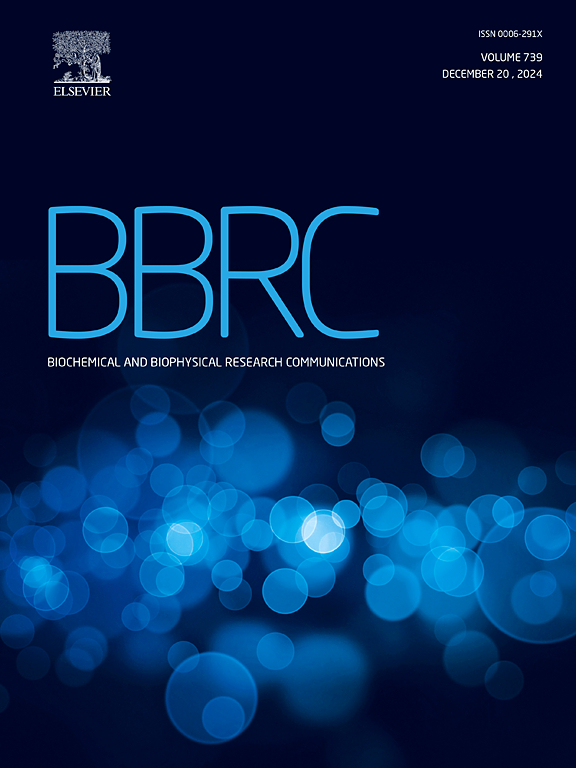Development of an indirect ELISA based on the VP1 protein for detection of antibodies against water buffalo Hunnivirus
IF 2.5
3区 生物学
Q3 BIOCHEMISTRY & MOLECULAR BIOLOGY
Biochemical and biophysical research communications
Pub Date : 2024-11-23
DOI:10.1016/j.bbrc.2024.151049
引用次数: 0
Abstract
Buffalo hunnivirus (BufHuV) is an important pathogen, which can cause diarrhea in water buffaloes, and as yet, there are no vaccines and drugs for its prevention and control. Here we studied the immunogenicity and predicted the three-dimensional structure of the BufHuV VP1 protein, in order to establish a rapid and efficient serological assay for detection of its antibodies in the host. The N-terminal truncated gene, consisting of amino acids 5–117, was selected and cloned into the prokaryotic expression vector pET-32a (+) to obtain the recombinant plasmid, pET-32a-BufHuV-VP1-1. These were then transformed into BL21 Escherichia coli to obtain BufHuV-VP1-1 recombinant proteins, which were then purified for used as coating antigens for ELISAs. An indirect ELISA was subsequently established by optimizing a series of operational steps. This VP1-1-ELISA had good specificity, sensitivity and repeatability, and the coincidence rate between the detection results and western blotting analysis was 95.8 %. A total of 997 clinical bovine serum samples were assessed by the VP1-1-ELISA, and the positive rate was 7.42 %. Overall, the VP1-1-ELISA established in this study is currently the first reported method to detect BufHuV serologically, and it will provide a powerful tool for the detection and epidemiological surveillance of hunniviruses in water buffaloes.
开发基于 VP1 蛋白的间接 ELISA,用于检测水牛匈奴病毒抗体
水牛浑病毒(BufHuV)是一种重要的病原体,可导致水牛腹泻,目前尚无疫苗和药物用于预防和控制。在此,我们研究了 BufHuV VP1 蛋白的免疫原性并预测了其三维结构,以期建立一种快速、高效的血清学检测方法来检测宿主体内的抗体。我们选择了由 5-117 个氨基酸组成的 N 端截短基因,并将其克隆到原核表达载体 pET-32a (+) 中,得到重组质粒 pET-32a-BufHuV-VP1-1。然后将这些质粒转化到 BL21 大肠杆菌中,获得 BufHuV-VP1-1 重组蛋白,然后将其纯化,用作 ELISA 的包被抗原。随后,通过优化一系列操作步骤,建立了间接 ELISA。这种VP1-1-ELISA具有良好的特异性、灵敏性和重复性,检测结果与Western印迹分析的吻合率为95.8%。VP1-1-ELISA 共检测了 997 份临床牛血清样本,阳性率为 7.42%。总之,本研究建立的 VP1-1-ELISA 是目前首次报道的从血清学角度检测 BufHuV 的方法,它将为检测和流行病学监测水牛中的匈奴病毒提供有力的工具。
本文章由计算机程序翻译,如有差异,请以英文原文为准。
求助全文
约1分钟内获得全文
求助全文
来源期刊
CiteScore
6.10
自引率
0.00%
发文量
1400
审稿时长
14 days
期刊介绍:
Biochemical and Biophysical Research Communications is the premier international journal devoted to the very rapid dissemination of timely and significant experimental results in diverse fields of biological research. The development of the "Breakthroughs and Views" section brings the minireview format to the journal, and issues often contain collections of special interest manuscripts. BBRC is published weekly (52 issues/year).Research Areas now include: Biochemistry; biophysics; cell biology; developmental biology; immunology
; molecular biology; neurobiology; plant biology and proteomics
文献相关原料
公司名称
产品信息
索莱宝
stop solution
索莱宝
TMB
索莱宝
IPTG
索莱宝
TMB

 求助内容:
求助内容: 应助结果提醒方式:
应助结果提醒方式:


